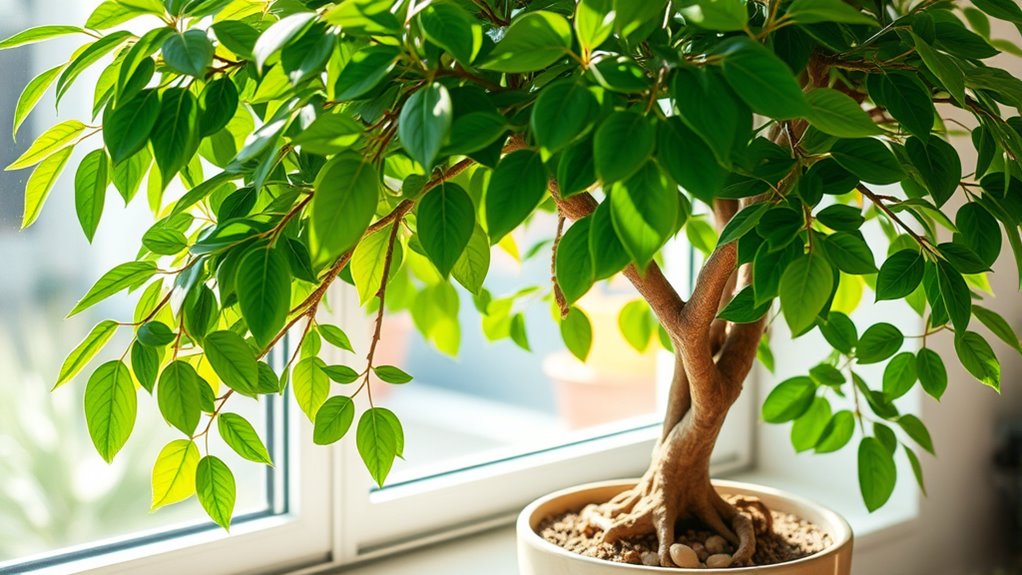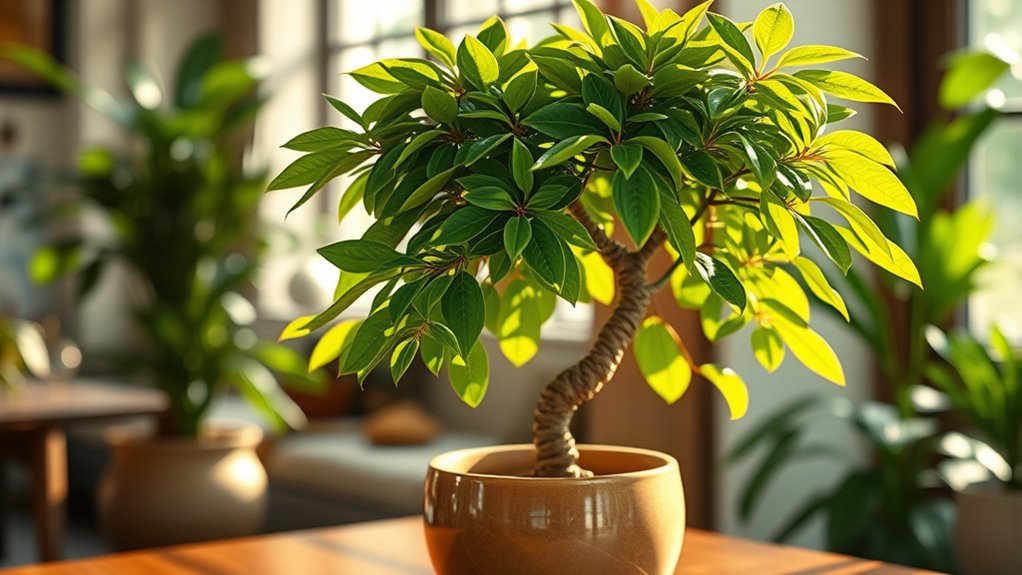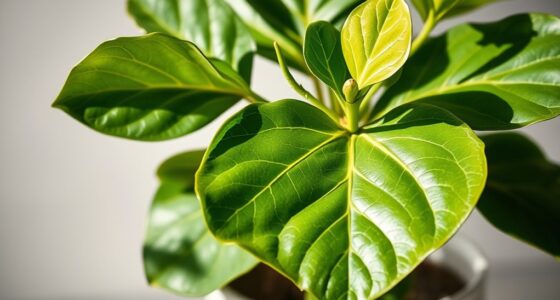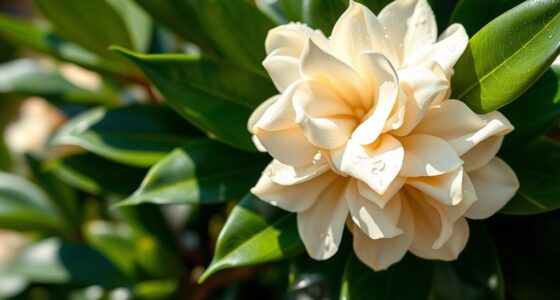To grow a prosperous money tree, place it in an area with indirect light, ideally in the southeast corner of your home for good feng shui. Water when the top inch of soil feels dry, about every 1-2 weeks in warm months and less in cooler seasons, ensuring excess water drains properly. Adjust watering based on your environment, and avoid drafts or fluctuating temperatures. Keep these tips in mind to nurture a healthy, wealth-attracting plant—more secrets await you.
Key Takeaways
- Place the money tree in the southeast corner or an area with indirect light to attract prosperity and promote feng shui harmony.
- Water only when the top inch of soil is dry, adjusting frequency based on environmental conditions and season.
- Ensure proper drainage to prevent root rot and avoid overwatering, which can harm the plant’s health.
- Keep the plant away from drafts, heating vents, and fluctuating temperatures for optimal growth.
- Regularly monitor plant appearance and environmental factors to maintain vitality and enhance its prosperity benefits.

Taking good care of your money tree guarantees it stays healthy and vibrant. To do this, you need to pay attention to essential aspects like feng shui principles and your watering schedule. Feng shui emphasizes creating harmony and positive energy in your space, and placing your money tree correctly is a big part of that. Position it in an area where it can receive indirect light, ideally near a window that doesn’t expose it to harsh sunlight, which can scorch its leaves. According to feng shui principles, placing your money tree in the southeast corner of your room or home is believed to attract wealth and prosperity. Keep it away from drafts, heating vents, or areas with fluctuating temperatures. This placement not only aligns with feng shui but also helps your plant thrive, as stability and good energy flow are key. Proper placement according to feng shui principles can enhance your space’s overall harmony and abundance.
Your watering schedule plays a vital role in maintaining your money tree’s health. Overwatering can lead to root rot, while underwatering causes dehydration and leaf drop. Typically, you should water your money tree when the top inch of soil feels dry to the touch. During warmer months, this might mean watering once every one to two weeks, but in cooler seasons, you can extend this to every three to four weeks. Always check the soil moisture before watering, and ensure excess water can drain freely from the pot’s drainage holes. Consistent, moderate watering helps keep your plant’s roots healthy and prevents issues related to over- or under-watering. Remember, it’s better to slightly underwater than overdo it, since excess water can sit in the pot and promote fungal growth.
In addition to proper watering, consider adjusting your watering schedule based on the environment—if your space is very dry or heated, your plant might need more frequent watering. Conversely, in humid or cooler areas, less frequent watering is sufficient. Monitoring your plant’s appearance is also vital; healthy, firm leaves indicate a well-maintained plant, while yellowing or drooping leaves suggest you need to tweak your watering routine or positioning. Adhering to feng shui principles for placement and maintaining a consistent watering schedule ensures your money tree remains a lively, thriving symbol of prosperity. When your plant is cared for with attention to these details, it becomes more than just a houseplant—it transforms into a vibrant, energetic centerpiece that can enhance your space’s harmony and abundance.
Frequently Asked Questions
How Often Should I Repot My Money Tree?
You should repot your money tree every 2-3 years or when it outgrows its current pot. During repotting, check its roots and refresh the soil. Adjust your watering schedule accordingly afterward to prevent overwatering. Incorporate fertilization tips by using a balanced, water-soluble fertilizer monthly during the growing season. This helps keep your plant healthy and thriving as it adapts to its new pot.
What Are Common Pests That Affect Money Trees?
You should regularly check your money tree for pests like spider mites, aphids, or scale insects. Pest identification helps you determine the best natural remedies, such as neem oil or insecticidal soap, to control infestations. Keep an eye out for discolored or sticky leaves, which signal pests. Prompt action with natural remedies guarantees your plant remains healthy and vibrant without harsh chemicals.
Can I Grow a Money Tree Outdoors?
You can grow a money tree outdoors, but you need to take into account its outdoor growth and sunlight requirements. Place it where it gets bright, indirect sunlight for most of the day, ideally in a spot protected from harsh afternoon sun. Ensure the soil drains well and keep it watered regularly. With proper care, your money tree will thrive outside, adding a touch of greenery and good luck to your outdoor space.
How Do I Prune My Money Tree for Health?
Pruning your money tree is like giving it a haircut to keep it healthy. You should use proper pruning techniques, trimming away dead or yellowing leaves and any overgrown branches. Seasonal trimming, usually in spring or early summer, encourages new growth and keeps the plant balanced. Always use clean, sharp tools, and avoid removing more than a third of the plant at once to prevent stress.
What Soil Mix Is Best for a Money Tree?
When choosing soil for your money tree, opt for a well-draining mix that prevents waterlogging and promotes healthy roots. You’ll want a blend that enhances soil drainage and meets the plant’s nutrient requirements. Use a combination of potting soil, perlite, or sand to guarantee proper aeration. This mix helps your plant stay healthy, encourages growth, and reduces the risk of root rot, keeping your money tree thriving indoors.
Conclusion
With proper care, your money tree will flourish, its glossy leaves shimmering like coins in the sunlight. Picture it standing tall and vibrant, spreading good fortune and lush greenery throughout your space. As you nurture it with water, light, and love, watch your prosperity grow alongside your plant. Soon, your home will be filled with the calming presence of this thriving houseplant—an enduring symbol of abundance and positive energy, rooted firmly in your care.









